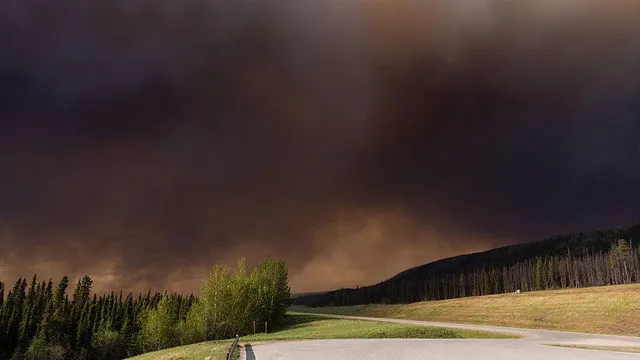
Manitoba declares state of emergency amid raging wildfires
2025-06-01 13:08- Manitoba is experiencing severe wildfires, leading to the evacuation of about 17,000 residents and the state's emergency declaration.
- Flin Flon has been particularly affected, with significant concerns for its 5,000 residents as winds threaten to carry fires into the city.
- Communities are coming together to provide support, but accommodations for evacuees are stretched thin as they face challenging living conditions.
Express your sentiment!
Insights
In Manitoba, Canada, wildfires have significantly impacted communities, leading to extensive evacuations. As of Saturday, approximately 17,000 residents have left their homes due to nearly two dozen active wildfires threatening areas from the northwest to the southeast of the province. Flin Flon, a city with about 5,000 residents, is notably affected, with warnings issued regarding fierce winds that could direct flames into urban areas. This prompted local officials, including the city’s mayor and healthcare staff, to evacuate. While there are currently no structure fires reported in Flin Flon, the situation remains precarious, with no rain forecasted in the immediate future. The mayor noted that unless conditions change drastically, the fire could breach city limits. The fires, fueled by strong winds, have necessitated the involvement of external aid, including firefighters from the United States and support from the Canadian Armed Forces to evacuate residents from surrounding regions. Evacuation centers have been set up across Manitoba, but with limited accommodations, communities like Winnipeg have opened public buildings to accommodate evacuees. The situation is further complicated by the smoke from these fires, which has drifted southward into the United States, affecting air quality. It is important to note that wildfires are a recurring concern in Canada, typically occurring from May to September, with the current situation ranking among the worst in history, affecting thousands across not only Manitoba but also Saskatchewan and Alberta.
Contexts
Wildfires have been a significant ecological and social issue in Canada throughout its history, affecting vast terrains and communities. The natural landscape of Canada, characterized by large forests and varied climatic conditions, makes it particularly susceptible to wildfires. Historical records indicate that wildfires in Canada have been occurring for thousands of years, playing a crucial role in maintaining the health of forest ecosystems. Indigenous peoples utilized fire as a land management tool to promote growth and maintain the landscape, showcasing a deep understanding of its ecological significance. However, the 20th century brought a shift in perception, with wildfires often viewed primarily as destructive forces, leading to extensive fire suppression policies that were implemented across the country. These policies created an artificial balance in forest ecosystems, resulting in an accumulation of fuel and increased risk for larger, more catastrophic fires in the future. Over the decades, the frequency and intensity of wildfires in Canada have fluctuated. Various factors contribute to the occurrence of wildfires, including drought, lightning strikes, and human activities. Recent climate change trends have exacerbated these factors, leading to longer fire seasons and larger areas being affected by wildfires. The summer months of 2020 showcased unprecedented fire activity in British Columbia, Alberta, and the Northern territories, drawing attention to the alarming rates of forest area loss. These events have transformed Canada’s fire management strategies, emphasizing the need for a more adaptive approach that accounts for changing climate conditions and the increasing role of human impact on landscapes. The socio-economic implications of wildfires are profound, affecting not only the environment but also communities, economies, and health. Displacement of communities due to evacuations, damage to infrastructure, and loss of property can have devastating consequences for affected populations. The psychological and cultural impacts of wildfires are often felt for generations, particularly among Indigenous communities who have a deep connection to these lands. Additionally, the economic costs related to firefighting efforts, recovery, and rehabilitation further strain resources, necessitating government intervention and public awareness. Wildfires also emit significant amounts of carbon dioxide, contributing to climate change, which creates a cyclical issue that requires careful consideration in policy-making. In light of these multifaceted impacts, Canada is evolving its wildfire management strategies to address the challenges posed by climate change and land management practices. Efforts are underway to shift from a reactive to a proactive approach that includes controlled burning, community engagement, and better land-use planning. Collaboration between governments, Indigenous communities, and researchers is vital for developing sustainable practices that balance ecological health with economic interests. As climate change continues to present new challenges, understanding the historical context of wildfires in Canada is crucial for preparing for future events and fostering resilience in both natural ecosystems and human populations.